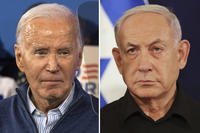A collection of defense think tank leaders said the Pentagon should retire its B-1 bomber fleet and cut near-term readiness money if it’s going to survive the next decade of sequestration.
The Center of Strategic and Budgetary Assessments recently held a “strategic choices exercise” to look at possible ways to cut the defense budget by $500 billion over the next decade. Todd Harrison, a senior fellow at CSBA told an audience Tuesday at the Air Force Association’s Air & Space Conference and Technology Exposition, about the results.
In addition to the CSBA, the American Enterprise Institute, the Center for a New American Security and the Center for Strategic and International Studies looked at 650 different budget options across all services.
“We sat down all these experts on four teams including CSBA and said ‘hey if you have to take these … sequester level cuts over the next 10 years and you have complete flexibility of how to allocate these cuts, go do it and show us what that looks like,’” Harrison said.
“What is the best you can do with over a half a trillion dollars worth of cuts?”
One of the programs most groups chose to target was legacy bombers. CSBA and CSIS recommended retiring all B-1 bombers and AEI recommended retiring both B-1 and B-52 bombers, Harrison said.
The recommendation was in line with the Defense Departments Strategic Choices and Management Review, which also recommended cutting the legacy bomber force.
“Ten to 20 years from now, we are going to need a bomber force,” Harrison said. “How do you do that? Well, if you are going to need a new bomber program, you may have to give up some of your legacy bombers.”
Force readiness was one area where they think tanks differed from the SCMR, which recommended to fully fund readiness.
“We gave teams the explicit option to cut back on near-term readiness; there is a lot of money in readiness right now and obviously that does a lot of good things it keeps our forces ready to fight,” Harrison said.
Despite the risk, all four think tanks chose to cut near-term readiness. Maintaining full funding for readiness means the cuts have to come from other areas including cutting the size of the force, Harrison said.
Cutting readiness “is a strategic choice and a difficult one … but that is a choice we allowed the teams to make and they did – all of them took some cuts in near-term readiness,” Harrison said.
“As we saw in 2013, the Air Force didn’t have much option but to ground some of its fighter squadrons temporarily," he said.
“When you look at the budget; when you’ve got to make cuts immediately … there is not a lot of quick money you can take out of the budget other than readiness. Readiness is quick money.”








